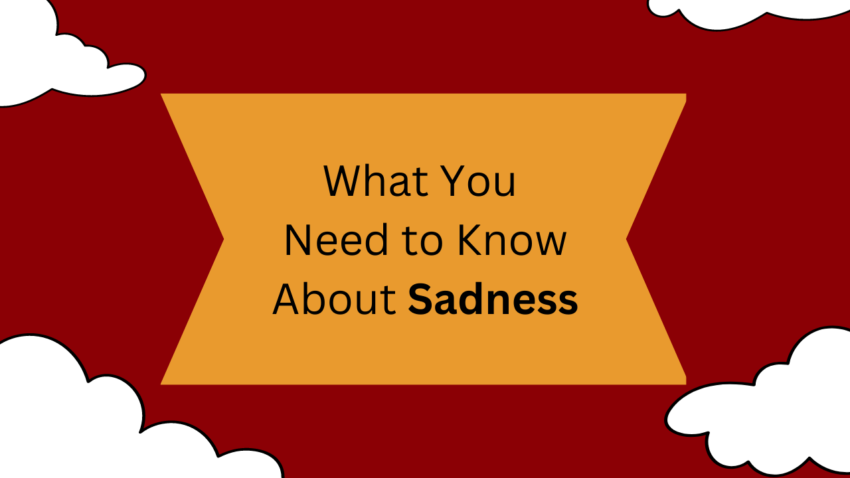Let’s Talk Sadness
In today’s video, we are tackling the category of emotions under the umbrella of Sadness. This large range of emotions all operate using the same biological processes, and we can use the same skills to increase or decrease each of the emotions in this category. In this video/article, you can learn what Sadness does for us, what it does for other people, how to recognize Sad emotions in ourselves and others, and what happens when we have too much Sadness.
What Are Sadness Emotions?
Each of the various emotions included under Sadness falls into a subcategory of emotions. When we experience emotions in these subcategories, it’s important to remember that everyone experiences the biological responses differently, but also that everyone associates different words with each feeling, since the words are a way of interpreting emotions. This means that they aren’t absolute truths, but are subjective. The categories used here mainly focus on the intended purpose of the emotion, rather than our interpretations of any given emotion.
Disappointment – something you hoped to obtain isn’t obtained
- Failure
- Discouraged
- Dismay
- Dissatisfaction
- Crestfallen
Loss – something you already had is taken away
- Grief
- Disorientation
- Heartbroken
- Sorrow
Boredom – lack of stimulation, occupation, or excitement
- Ennui
- Loneliness
Pain – the feelings that reflect the pain of change.
- Anguish
- Distraught
- Discomfort
Hopelessness – The feelings that indicate things can’t get better
- Despair
- Helplessness
- Gloom
Causes of Sadness
Sadness is caused when our brain interprets our situation and concludes that something has been lost. The loss can be anything, really. We experience sadness when we lose people, things, hopes, dreams, goals, ideals, or even more intangible things. We don’t already have to have the thing we lose. We can experience sadness emotions when we lose the possibility or hope of having the thing.
Specific interpretations include:
- I wanted X but it is no longer available.
- I had X but it is gone.
- Someone died, and I can no longer interact with them.
But why do we feel the way we do when we have Sadness emotions? Unlike Happiness, there’s not a specific collection of chemicals responsible for Sadness emotions. Instead, Sadness is a result of our brain taking available energy and funneling it into creating, altering, or updating our memories. These memories include memories of events, our hopes, and the status of various things. While our brain is focusing energy in this way, we produce less of the Happiness chemicals like dopamine and endorphins.
What’s the Point of Sadness?
The key message that accompanies sadness is “Something has changed.”
Pain
It’s important to remember that when we are sad, we are changing memories. Scientists have been able to prove that altering a memory can cause physical pain. One facet of sadness is that we feel pain, but the sadness also creates an internal distance called dissociation that may actually protect us from the pain involved in changing significant memories.
“Stop it”
Sadness often comes with a message telling us to stop something. This might be pretty straightforward, like “Stop investing in someone who hurts you”, but it might also be more nuanced, such as “Find another way to do this.” There’s no guidebook in our brain that tells us how to interpret these messages, so it’s not uncommon for someone to interpret their sadness as a signal to stop something unrelated to the initial cause of the sadness.
Protect
Sadness also signals us to take protective measures. Whether this looks like guarding our heart against emotional hurt, or protecting our children when they are hurt, Sadness helps us prioritize the safekeeping of the things we care for.
Communication
Sadness is also a tool we use to communicate with others. When we are sad, we are sending messages to our community that we need support. This might look like having less energy while our brain processes the loss we’ve experienced, but it might also look like having company or entertainment when we are bored or lonely.
For example, when we experience a loss of a close loved one, our quietness, crying, and other signs of sadness encourage other people to look for ways to help us. The fact that we are sad prompts a sadness in them, as well, which can trigger the “Protect” instinct. This is why it’s so common across so many cultures to bring food to a grieving family, or to take care of errands or cleaning while they are grieving. The sadness lets them know we need help when we aren’t able to care for ourselves.
What Does Sadness Look Like?
Sadness is a deeply personal experience, and it can be difficult to identify it in some people. That said, we have specific biological responses to sadness that we can recognize in ourselves and others. We have specific feelings and action urges that influence how we think and behave, which can help us identify sadness.
Action Urge: The physical actions our bodies want to take in response to feeling an emotion.
Crying
The easiest Sadness experience to identify is crying. From a young age, children learn to recognize tears as a sign of sadness. Tears are less common in adults, however, because we learn various ways to control or hide our emotions. Men and women are both taught, in different ways, that crying is socially inappropriate, but this is not healthy, because sadness and crying are critical human experiences. Boys are often taught that crying is a weakness or “too feminine.” Girls are often taught that crying is “ugly”. In order to have a healthy relationship with Sadness, we need to foster a healthy relationship with crying.
Crying is a pain reliever. When we cry, we release oxytocin and endorphins, which help ease pain. When we suppress the urge to cry, we are actively refusing our natural pain relief and, ultimately, happiness.
Avoiding
A common action urge for Sadness is to avoid things that might cause us pain. We might avoid risk, other people, or even activities that normally cause us to feel happy.
Wallowing
Another common urge we have when we are sad is to wallow in that feeling. We might listen to or watch sad things. We might talk about being sad, or feeling hopeless. We also might feel like nothing can change, and feel like giving up.
Miscellaneous Sadness Responses
When we are trying to identify Sadness in ourselves and others, we can also look for the effects of our brains pouring energy into memory, and in turn not having energy for other things. Speaking in a monotonous voice, for example, or not talking much are both indicators. Other things look like poor posture, not opening our eyes as much as usual, shuffling our feet when we walk, or having poor balance are all indications that our brain isn’t giving us full access to our normal energy supply.
It Goes Two Ways
Remember that you can use these tools to identify Sadness in yourself and others. The same urges you have might look like actions someone else takes which indicate that they are sad.
Aftereffects of Sadness
When we experience Sadness, it has ongoing effects on our feelings and behaviors, even if we aren’t sad anymore. We might feel irritable or grouchy. We might also ruminate or be fixated on sad things that have happened in the past. We might also have a negative outlook, insomnia, or loss of appetite.
A critical aftereffect of Sadness is the tendency to blame, criticize, or judge ourselves. This is a normal response when our brain is looking for ways to avoid feeling sad again in the future. But we do have to keep in mind that we aren’t magicians or mindreaders. We cannot control other people, or things outside of our own scope, and we need to let go of the urge to blame ourselves for things that aren’t our responsibility.
Finally, an aftereffect of Sadness is to have difficulty feeling happy or peaceful. The longer we sit in uninterrupted Sadness, the harder it is to feel other emotions, so it’s important to make room for small amounts of happiness to help us recover long-term.
Changing Emotions
All emotions have other emotions that they are capable of wearing down or are susceptible to. Sadness can be easily overwhelmed by anger, fear, or disgust because they cause us to redirect energy to our bodies and away from our brains. When we are experiencing sadness, it’s important to recognize that it’s easier for us to be convinced to be angry at, afraid of, or disgusted by almost anything when prompted to feel that way by others. This is one reason the tyrants who are responsible for the bloodies and cruelest wars often come from populations dealing with great amounts of sadness that they use to create fear, anger, and disgust in the population to motivate them to commit to whatever their cause is.
A good example of this is Hitler’s motivation of downtrodden German citizens by scapegoating outsiders, disabled people, and different ethnic groups. He convinced the population that these people were to be feared, hated, or disgusted by, and led the country into a war that didn’t match the normal values of the population.
On the other hand, Sadness has a two-way relationship with Happiness. This is because Sadness is the primary way we deconstruct attachments to people, places, and things. But, when given new sources of Happiness, our brains will latch onto the new source of comfort and release the Sadness, at least for a while.
When Sadness Goes Wrong
When we experience too much Sadness, we can develop depression, which is a chemical imbalance with its own range of symptoms, which may need medical intervention, but may go away on its own. It’s important that you recognize Sadness and take steps to return to a more neutral space that allows other emotions over time.
When we don’t experience Sadness, we may have an impeded ability to make or update memories. You may also not be recognizing failures or losses you’ve been exposed to, which may make you less effective in professional and social situations, and affect your insight to your own abilities. You may also be more likely to feel confident, knowledgeable, or courageous even when it isn’t warranted.
Want More Sadness?
I have previously covered Happiness. Over the next few weeks, I’ll be covering Anger, Fear, and Disgust. Once each of these introductory posts are available, I’ll start covering specific skills to increase or decrease Happiness, based on what your needs are. There will also be lessons on how to evaluate your emotions to see if you are, in fact, experiencing emotions warranted by and appropriate to your experience, as well as knowing whether the emotions are effective in that moment. These skills will apply to all forms of Sadness, since there are only a few biological and psychological processes involved in Happiness responses.
If you have questions, shoot me an email at Rory@UpRoryUs.com
Thanks for stopping by, and remember to be kind to yourself and others.

